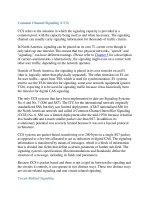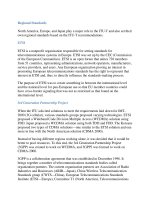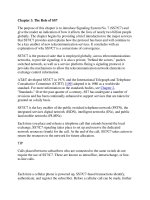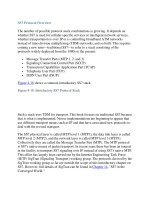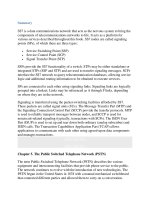Signaling System No.7 Protocol Architecture And Sevices part 23 ppsx
Bạn đang xem bản rút gọn của tài liệu. Xem và tải ngay bản đầy đủ của tài liệu tại đây (47.86 KB, 8 trang )
Detailed Call Walk-Through
Earlier in this chapter, we presented an ISUP message flow in order to illustrate the
exchange of messages to establish and release an ISUP call. Now that we have
discussed more of the ISUP details, we will build on that illustration. This section
p
rovides more detail about the call processing that was driven by the ISUP
message events used in the earlier example. Although this chapter's primary focus
is the ISUP protocol, it is important to understand how ISUP is applied in its
normal domain of trunk call processing.
Call Setup
Refer back to Figure 8-3
, where a call originates from a line at SSP A and
terminates to a line at SSP B over an interexchange ISUP trunk. When call
p
rocessing has completed translations of the called number at SSP A, the
translations' results indicates that the call requires routing to an interexchange trunk
group. The provisioned signaling type for the selected trunk group determines
whether ISUP signaling or some other signaling, such as Multifrequency (MF), is
used. When the signaling type is determined to be ISUP, the trunk circuit to be
used for the outgoing call is reserved for use.
The SSP populates the IAM with information about the call setup, such as the CIC,
CdPN, Call Type, CgPN, and PCM Encoding scheme. The IAM information is
p
laced in the User Data field of the MTP3 SIF. The MTP3 information is
p
opulated based on the SS7 network information that is associated with the
selected trunk group. As previously noted, each switching exchange contains a
p
rovisioned association (usually static) between routesets and trunkgroups. The
IAM is then transmitted onto a signaling link toward the destination identified in
the message by the DPC. If quasi-associated signaling is used, the message's next-
hop node is an STP that will route the message to the intended SSP. If associated
signaling is used, the IAM is transmitted directly to the SSP that is associated with
the trunk being set up. SSP A starts timer T7, which is known as the network
p
rotection timer, or the awaiting ACM timer, to ensure that an ACM is received in
response to the IAM.
When SSP B receives the MTP3 message, it recognizes it as an ISUP message by
the SIO's Service Indicator bit. Then the message is passed to ISUP for processing,
during which it extracts the message information. An IAM indicates a request to
set up a call so SSP B enters the call processing phase for a trunk origination. The
CdPN and Calling Party Category fields provide key pieces of information from
the IAM for SSP B to complete number translations for this simple call.
N
OTE
The CdPN is commonly used to enter number translations processing; however,
depending on call specifics, other fields can be used for translation. For example,
calls involving ported numbers can use the Generic Address Parameter during
number translation to determine the outgoing call destination.
In this example, the number translates to a subtending line of SSP B, which checks
the line to determine whether it is available. An ACM is built and sent to SSP A,
notifying that the call can be completed and is proceeding. At this point, the speech
p
ath in the backward direction (from SSP B to SSP A) should be cut through to
allow the ring-back tone to be sent over the bearer channel from the terminating
exchange to the originating exchange. This indicates that the terminator is being
alerted.
N
OTE
N
ote that the terminating office does not always send the ring-back tone. For
example, ISDN can use the ACM message to notify the originating phone terminal
to provide the ring-back tone.
Ringing is now applied to the terminating set, while ring back occurs at the
originating set. Answer timing is usually applied at the originating switch to limit
the amount of time an originator waits for answer.
When the terminating subscriber goes off-hook, an ANM is sent back to the
originator to indicate that an answer has occurred. By this point, the voice path
should be cut through in the forward direction to allow the conversation to take
p
lace. Note that the voice path can be cut through before receiving the ANM, but it
must be cut through no later than the ANM. The call is now in the active, or
talking, state. This is often a point of interest for billing procedures that require
capturing the time at which a call conversation begins. For an ordinary call, no
further signaling messages are exchanged for the duration of the conversation.
When either of the parties goes on-hook, it initiates signaling for the release of the
call. The following section discusses Call release.
Call Release
When either the originating or terminating subscriber goes on-hook, it signals an
attempt to disconnect the call. In Figure 8-3
, the originator at SSP A goes on-hook.
SSP A recognizes the signal to disconnect the call and sends a Release message
(REL) to SSP B. SSP B responds by sending a Release Complete message (RLC)
as an acknowledgement. The trunk member is freed and placed back into its idle
queue to be used for another call.
Terminal Portability
The ITU defines terminal portability in Q.733.4 for allowing the called or calling
p
a
r
ty to hang up a phone and resume a conversation at another phone that is
connected to the same line. When the two parties are connected over an inter-
exchange ISUP trunk, suspend and resume messages are used to maintain the trunk
connection until the on-hook party has gone off-hook. Terminal portability
requirements for the called party exist in many countries; however, terminal
p
ortability for the calling party is not supported as often. ANSI networks do not
support terminal portability for the calling party.
< Day Day Up >
< Day Day Up >
Circuit Suspend and Resume
In Figure 8-3
, the originating subscriber goes on-hook first. The originator is
normally considered in control of the call, so the circuit is released when the
originator goes on-hook. If the terminator goes on-hook while the originator
remains off-hook, there are two methods of handling the disconnection.
The first method is for the terminating exchange to release the call by sending a
REL message to the originating exchange. This is no different than the scenario
p
resented for a release initiated at the originating exchange; the originating switch
responds with an RLC and the circuit is idled at each SSP.
The other method is for the terminating exchange to send a Suspend (SUS)
message in the backward direction when it receives a disconnect indication from
the terminating line. The SUS message provides notification that the terminating
p
arty has disconnected but that the circuit connection is still being maintained.
Suspending the call allows the person who receives the call an opportunity to pick
up on another phone extension.
When the SUS is received, the originating exchange starts a suspend timer (Timer
T6, or Timer T38 in the case of an international exchange). If the terminating party
reconnects (off-hook) before the suspend timer expires, a Resume (RES) message
is sent in the backward direction, allowing the conversation to continue.
Figure 8-16
shows an example of a Suspend (SUS) and Resume (RES) being sent
from the terminating exchange. If the suspend timer expires, a REL is sent in the
forward direction. In the event that the originator goes on-hook during the time the
circuit is suspended, the originating exchange sends a REL forward and normal
call clearing takes place. The terminating exchange responds with a RLC.
Figure 8-16. ISUP Suspend/Resume
Support for SUS/RES varies, based on factors such as the type of service and the
local network policies. For example, in the United States, SUS/RES is only
supported for non-ISDN service.
< Day Day Up >
< Day Day Up >
ISUP and Local Number Portability
Local Number Portability (LNP) is the concept of having phone numbers that
remain the same for the subscriber, regardless of whether the subscriber changes
service providers or geographic location. Historically, phone numbers have been
associated with a particular geographic region or a particular service provider. The
actual use of LNP in the network exists today, but only to a small degree. It is
being expanded in phases and will take some time before it is ubiquitous across all
networks and locations. This section examines the different mechanisms used to
p
rovide portability services and how these mechanisms relate to setting up calls
with ISUP.
Chapter 11
, "Intelligent Networks (IN)" provides an overview of the various
p
hases identified under the umbrella of Number Portability (NP), such as service
p
rovider portability and location portability. Some of the mechanisms used for NP
employ Intelligent Network (IN) databases, so we cover NP in part both in the
Chapter 11
and in this chapter.
When NP is implemented, numbers are transitioned from physical addresses that
identify an exchange location to virtual addresses that identify a subscriber. A
means of mapping must be used to derive a physical address in the network from
the called number because the number no longer identifies a physical destination.
The network in which the physical number existed before portability was
introduced is called a donor network. Each time a number is ported and becomes a
virtual address, the network has "donated" a number that previously belonged to
that network. We use the term "donor" or "donor network" several times during the
discussion of NP. The network in which the physical number now resides is called
the recipient network.
Currently, four mechanisms are defined for implementing NP:
• All Call Query (ACQ)
• Query on Release (QOR)
• Dropback or Release to Pivot (RTP)
• Onward Routing (OR)
Each method has its merits in terms of resource efficiencies, maintainability, and
competitive fairness among network operators, but those topics are outside of the
scope of the book. The details of how each mechanism is implemented also vary
from country to country. The following section provides a general understanding
of NP and how it affects the ISUP call flow and messages.
A
ll Call Quer
y
(ACQ)
ACQ sends an IN query to a centrally administered database to determine the call's
p
hysical address or routing address. Chapter 11 discusses the details of the IN
query. The way the routing number returned by the query is used varies based on
national standards. The following example illustrates how the routing number is
used in North America.
The number returned from the database is a Location Routing Number (LRN) that
identifies the exchange serving the called number. Each exchange in the network is
assigned an LRN. The IAM sent after the database query is performed contains the
LRN in the CdPN field. The call is routed on the CdPN using switching
translations to reach the destination exchange. The IAM also includes a Generic
Address Parameter (GAP) with the original dialed number (the virtual address).
This allows the destination exchange to set up the call to the intended subscriber
because the LRN can only identify the exchange. The Forward Call Indicators of
the IAM include a Ported Number Translation Indicator (PNTI), which indicates
that a query for the ported number has been performed.
Query On Release (QOR)
QOR routes the call from the originator to the donor network's ported number in
the same manner used prior to NP. The donor network releases the call back with a
cause value of Number Portability QOR number not found (ITU causes value 14,
ANSI causes value 27 in the REL message). The originating network then
p
erforms a query to an NP database to determine what routing number to use in the
IAM in order to reach the recipient network.
D
ropback (Also Known as Release to Pivot)
Dropback, or Release to Pivot (RTP), routes the call to the ported number in the
donor network, just like QOR. However, instead of having the originating network
query for the number, the donor exchange provides the routing number for the
p
orted number when it releases back to the originator.
Onward Routing (OR)
Onward Routing (OR) also routes the call to the donor network's ported number. It
differs from QOR and RTP in that it does not release the call back to the
originating network. Rather, it references an internal database to determine the new
routing number that is associated with the ported number and uses the new number
to route the call.
Using the QOR and RTP mechanisms, an IAM is sent and an REL received back
from the donor network, therefore, requiring a subsequent call attempt. The ACQ
and OR do not release back or require subsequent call attempts. The OR
mechanism creates additional call legs because the call is being connected through
the donor network rather than being directly set up to the recipient network.


